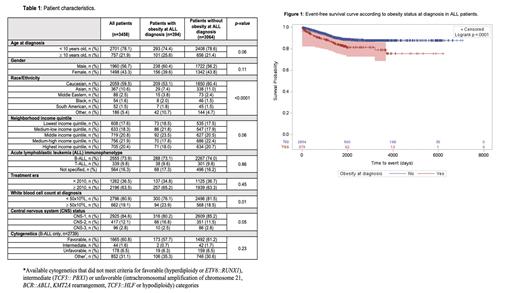Introduction
Childhood obesity can result in a variety of adverse health outcomes and it has been associated with inferior survival in children and adolescents with acute lymphoblastic leukemia (ALL). With the rising incidence of childhood obesity in Canada, we seek to assess the prevalence of obesity and its prognostic significance in children and adolescents with newly-diagnosed ALL in Canada.
Methods
We conducted a retrospective cohort study using the Cancer in Young People in Canada (CYP-C) database, a national population-based pediatric surveillance program collecting in-depth clinical data from all cancer patients <15 years old before 2015 and <19 years old after 2015 in Canada. This study included patients aged 2 to 18 years old with newly-diagnosed ALL and treated at one of the 17 pediatric oncology centers across Canada from January 1, 2001 to December 31, 2020. Obese patients were defined as patients with a body mass index (BMI) at or greater than the 95 th age and sex-adjusted percentile as per the Centers for Disease Control & Prevention (CDC). Patients <2 years old were excluded given no BMI data could be derived from CDC growth charts. The main outcomes were event-free survival (EFS) and overall survival (OS). EFS was defined as time from ALL diagnosis to first event (relapse or death). OS was defined as time from ALL diagnosis to death from any cause. Patients without an event were censored at date of last contact. Predictors of obesity were explored using logistic regression. Univariate and multivariable Cox proportional hazards models were used to compare EFS and OS between patients with and without obesity.
Results
A total of 3458 ALL patients were included. The median BMI was 16.4 kg/m 2 (interquartile range (IQR): 15.2-18.1 kg/m 2). Eleven percent of children were obese at the time of ALL diagnosis. The prevalence of obesity significantly increased over time compared to that at ALL diagnosis: 18.9% at 1 year (p<0.0001), 25.8% at 2 years (p<0.0001), 23.3% at 3 years (p<0.0001), 21.8 % at 4 years (p<0.0001) and 20% at 5 years (p<0.0001). The prevalence of obesity did not vary according to age at diagnosis, gender, neighborhood income quintile (NIQ), ALL immunophenotype and treatment era ( Table 1). Non-Caucasian race (odds ratio (OR): 1.35 [95% confidence interval (CI) 1.09 -1.67]; p=0.005), presenting white blood cell (WBC) ≥ 50 x 10 9/L (OR: 1.38 [1.07 - 1.77]; p=0.01) and central nervous disease (CNS) disease (OR: 1.44 [1.10 - 1.88]; p=0.009) were significantly associated with increased risk of obesity at diagnosis. The 5-year EFS of obese patients at ALL diagnosis were significantly inferior to those of non-obese patients (85.3% vs. 90.6%; p=0.0008) ( Figure 1). The 5-year OS was 90.4% for obese vs. 94.9% for non-obese patients at diagnosis (p=0.003). The causes of death in the entire cohort were 1) related to disease (73.5%); 2) related to treatment toxicities (15.6%); and 3) due to other causes (10.9%). In univariate analysis, obese patients at ALL diagnosis had a higher risk for worse EFS (Hazard Ratio (HR) 1.76, 95% CI 1.34 - 2.32, p<0.0001)and OS (HR 1.99, 95% CI 1.41- 2.81, p<0.0001) compared to non-obese patients. In addition, age ≥ 10 years old at diagnosis, CNS disease, presenting WBC count ≥ 50x10 9/L, non-favorable cytogenetics and treatment era before 2010 were also significantly associated with worse EFS and OS in univariate analyses. In multivariable models controlling for patients' age at diagnosis, gender, presenting WBC, CNS status, NIQ, ethnicity, treatment era and ALL immunophenotype, obesity at ALL diagnosis retained independent significance with a HR of 1.67, 95% CI 1.26-2.21, p=0.0004 for EFS and a HR of 1.83, 95% CI 1.29-2.61, p=0.0008 for OS.
Conclusion
In this population-based study of children and adolescents with ALL in Canada, obesity was found in 11% of patients at ALL diagnosis, peaked at 2 years and remained significantly increased at 5 years from initial diagnosis. Patients with higher risk features such as WBC ≥ 50 x 10 9/L and CNS disease were more likely to be obese at diagnosis. Nevertheless, obesity at ALL diagnosis remained independently associated with inferior EFS and OS even after adjustment for these high-risk features. More mechanistic studies are needed to better understand the relationship between obesity and outcome to inform future trial designs.
Disclosures
Tran:Servier: Consultancy, Honoraria; Jazz Pharmaceuticals: Consultancy, Honoraria.


This feature is available to Subscribers Only
Sign In or Create an Account Close Modal